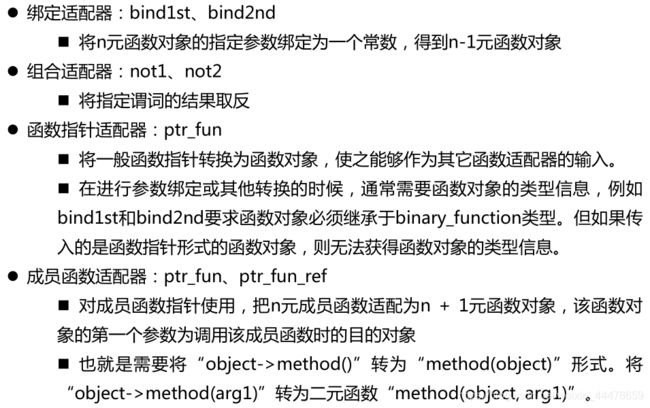8.21C++:函数对象、STL提供的函数对象、函数适配器
1 函数对象
- 函数对象是行为类似函数的对象。一个类对象,表现出一个函数的特征,即通过对象名+(参数列表)的方式使用一个类对象。
- 使用STL中提供的或自定义的迭代器和**函数对象,**配合STL的算法,组合出各种各样的功能。
- 通过函数对象而不使用函数指针,可以增加通用性,提高效率。为什么使用函数对象
- 函数对象概念:泛化的函数

①将普通函数作为函数对象:传递函数名
#include ②将重载了()运算符的类的对象作为函数对象:传递"类名()"
#include 2 STL提供的函数对象

1.系统提供函数对象帮助实现基本功能。
2.accmulate算法接受二元函数对象,transform算法接受一元函数对象。
①STL库的multiplies
#include ②STL库的二元谓词greater
#include 中,默认是升序
copy(arr, arr + N, ostream_iterator<int>(cout, "\t"));
return 0;
}
3 函数适配器
适配器顾名思义,让函数适配算法。
Unary Predicate:一元谓词
binary:二元的
bind:结合,(使)联合在一起


①找出第一个大于40的数,注意用数组和vector都可以
#include 一般使用数组初始化向量vector,后续操作更方便
int main()
{
int a[] = { 30, 40, 50, 90, 20, 10 };
const int N = sizeof(a) / sizeof(int);
vector<int> v (a, a + N); //用数组初始化vector
vector<int>::iterator p = find_if (v.begin(), v.end(), bind2nd(greater<int>(), 40) );
if (p == v.end())
cout << "找不到" << endl;
else
cout << *p << endl;
return 0;
}
find_if算法在STL中的原型声明为:
template<class InputIterator, class UnaryPredicate>
InputIterator find_if(InputIterator first, InputIterator last, UnaryPredicate pred);
它的功能是查找数组[first, last)区间中第一个pred(x)为真的元素。
InputIterator、UnaryPredicate是用概念来做模板参数名
②利用prt_fun、not1、not2产生组合适配器
#include ③成员函数适配器,类的成员函数要通过适配器转换为普通函数对象
#include 为什么不能同全局函数一样直接传递函数名而成员函数必须以 &类名::函数名 的方式,因为需要考虑static成员函数的情况。
mem_fun(member适配为function):将成员函数适配为普通函数对象,适配出来的函数需要对象的指针作为参数。
men_fun_ref:将成员函数适配为普通函数对象,适配出来的函数需要对象的引用作为参数。